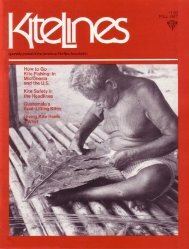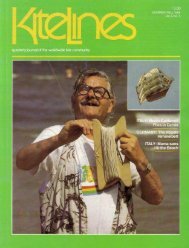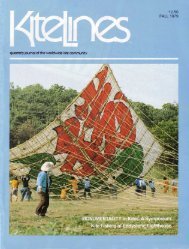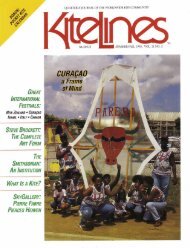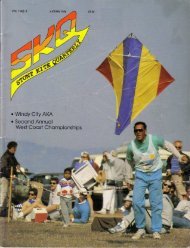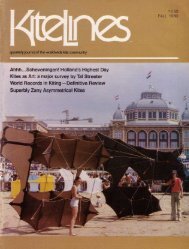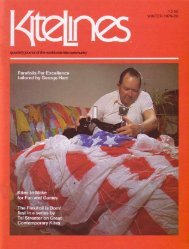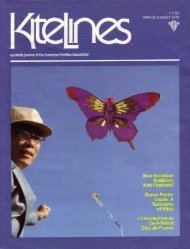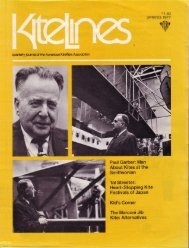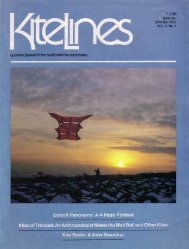Create successful ePaper yourself
Turn your PDF publications into a flip-book with our unique Google optimized e-Paper software.
near the ground, so that you learn topredict the kite's responses .Finally, come equipped with extratape, covers, sticks (or kites) if youplan to fly for a long period .We were flying in very strong winds,about 25 miles per hour-good conditionsfor stunting . We found thatperformance differences, for theaverage flier, were slight from kite tokite . In general, the smaller the kite,the faster it responded and the quickerand shorter were the maneuvers . Themore flexible the struts (fiberglass wasthe most flexible), the more sluggishthe kite and the slower the turns .<strong>Kite</strong>s with the three-prong nosedesign (such as the Peter Powell)seemed to bounce and glide off theground and land gently except in ahead-on dive at the earth . This resilienceis important, since bouncingseems to be inevitable . The Sky Tigerand the Super Stunter tipped on theirnoses, resulting in a torn cover on oneand a broken stick on the other. TheDunford suffered a broken stick in aground collision . Durability becomesthe standard for selection since performanceof all these kites is adequate .Most of the kites were covered in5-mil polyethylene . This seemed to bea worry-free choice . Two had lighterpoly covers which were not strongenough for our winds, although theymight have been better in lighter windsbecause of their lesser weight .Spectacle is a big part of stunterflying . Tails add a lot to this withoutaffecting the flight performance much .The tubular tail of the Peter Powell isespecially dramatic . It follows the pathof the kite in long casual loops . Eventhe long flat polyethylene tails areTriple Powells at Old Warden field, England .attractive . Tails tend to make the loopsand rolls look planned, whereas a flightwithout them might look to a bystanderlike an operation out of control,no matter how masterfully you fly .All the controllables are quite easyto assemble and transport, except theDunford, which takes about 15 minutesto assemble . Also the Windjammerhas a drawback. Its cross bar was largerin diameter than the tubes receivingit . Some fancy whittling was requiredto make it fit .As a lover of fighter kites, I ampleased to add the two-line stuntersto my kite bag . In general, when afighter kite flies well (four to eightmile-per-hour breeze), a stunter won't .And when a stunter flies well (over 10mile-per-hour wind), the fighterseither have become unmaneuverablystable or have been destroyed . So, ifyou like kinetic kites, the fighters andthe stunters complement one anothernicely.Some of this issue's test models were suppliedby The <strong>Kite</strong> Site, Georgetown, DC .The Dunford model was lent by MarvinTyrrell of Delmar, DE .POSTSCRIPT : GETTING A GRIPON THE CONTROLLABLESBy Bruce PfundSeven years ago I purchased aninexpensive two-line maneuverablekite, which was demolished by the timeI had gained an inkling of how to flythe darn thing .Since then I've logged over 2500hours flying two-stringers, testingalmost 30 kites of my own design, andtrying for increased maneuverability,speed and durability .The dynamics of two-line control areessentially the same for all maneuverablekites, but performance of modelsvaries . Here are some definitions,principles and rules of thumb I'velearned for the maneuverables .DynamicsWhen launched with both lines exactlythe same length, the stunter kite willbehave just like any other kite . It willzoom up to maximum elevation andstay there, an equilibrium-seeking kite .When the line lengths are changed,the kite will be turned, because thekite has been tilted to the wind alongthe backbone axis, and the two halvesof the kite skin generate unequal lift .The pull on each line is a functionof its length relative to the kite . Theshorter line will have the greater pull,and the kite will turn to this side .Pull on both lines is equal and minimumwith the wind at your back andthe kite at maximum elevation . Pullis maximum when the kite is closest tothe ground and will decrease as thekite gains altitude or approaches theright or left hand limits of the wind .One-line kites fly at a fixed angleof attack, whereas two-line kites undergochanges in the angle of attack asthey traverse the wind .Both the speed and the rate of turnincrease as the angle of attack increases .The kite never travels at a fixed speedbut actually is always accelerating ordecelerating . What starts out as a largediameterturn from a high altitude willrapidly become a faster, tighter turn



